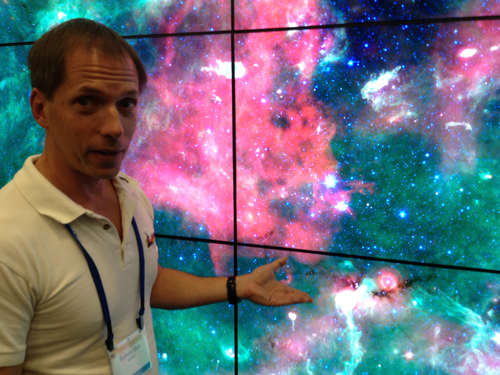Science News
Stars are Born

Reporting from day two of the American Astronomical Society meeting in Austin, Texas…
Much like people, stars live and die. But the processes of stellar birth and death present many mysteries for astronomers to resolve. Stars tend to form in clusters, in dense regions rich in gas and dust.
Joseph Hora, of the Harvard-Smithsonian Center for Astrophysics, described a detailed look at the star-forming region Cygnus X—and the Spitzer Science Center released a gorgeous, high-resolution image of the region to coincide with the announcement. (Today’s photo shows Robert Hurt, Visualization Scientist with Spitzer, describing details of the image displayed on a high-resolution power wall at the NASA science display.)
An infrared survey of about 25 square degrees (equivalent to the area of more than a hundred full moons) revealed nearly 26,000 possible “young stellar objects” (or YSOs), stars captured early in their evolution, still enshrouded by dense dust. The bright, young stars heat up all that dust, so astronomers look for excess emission in infrared light, and the high-resolution image allowed astronomers to find lots of (relatively) tiny objects and put them in context with the larger region. You can read more about the image and the discoveries in the official Spitzer press release.
Xavier Koenig, from NASA Goddard, presented infrared imagery from the Wide-field Infrared Survey Explorer (WISE) and described his work in studying how star formation is triggered inside one of these regions. Extremely massive stars tend to form first, near the center of a collapsing gas cloud, but what happens next can prove difficult to disentangle: stars don’t arrive on the scene with birth certificates, after all, so astronomers need to determine which ones formed when.
Koenig’s data suggest that the massive stars set of a chain reaction of star formation, with smaller stars forming outward from the center of a gas cloud. Or as the WISE team describes it:
The results suggest that stars are born in a successive fashion, one after the other, starting from a core cluster of massive stars and moving steadily outward.
Massive stars can also wreak havoc on their surroundings. Erick Young, science mission operations director for NASA’s Stratospheric Observatory For Infrared Astronomy (SOFIA),described observations of the W3 star-forming complex that reveal the effects of the stellar winds and radiation from the largest stars in the region. Eventually, all this activity will tear apart the very gas cloud that gave birth to the stars.
NASA describes the image in some detail:
The SOFIA observations reveal the presence of some 15 massive stars in various stages of their birth process. Toward the left of the inset image, a small bubble (arrow) has been cleared out of the gas and dust by the most massive star in this cluster. This bubble is surrounded by a dense shell (green) of material in which some of the dust and all of the large molecules have been destroyed. That shell is surrounded by mostly untouched cloud material, traced by the red emission from cooler dust. Astronomers have evidence that the expansion of such bubbles around massive newly born stars acts to compress nearby material and trigger the condensation of more stars.
SOFIA, by the way, has its home in California: headquartered at NASA Ames, the flying observatory takes off from the Dryden Aircraft Operations Facility in Palmdale. A 747SP equipped with a 2.7–meter telescope (and a big hole in the side of the aircraft), SOFIA flies high enough to make observations at wavelengths of light that don’t make it to Earth’s surface. And on February 6th, Erick Young will speak at the Morrison Planetarium as part of our Benjamin Dean Lecture Series, so attendees can learn more about the observatory—and star formation, I’m guessing—from Erick in person.
Ryan Wyatt is the director of the Morrison Planetarium and Science Visualization at the California Academy of Sciences.